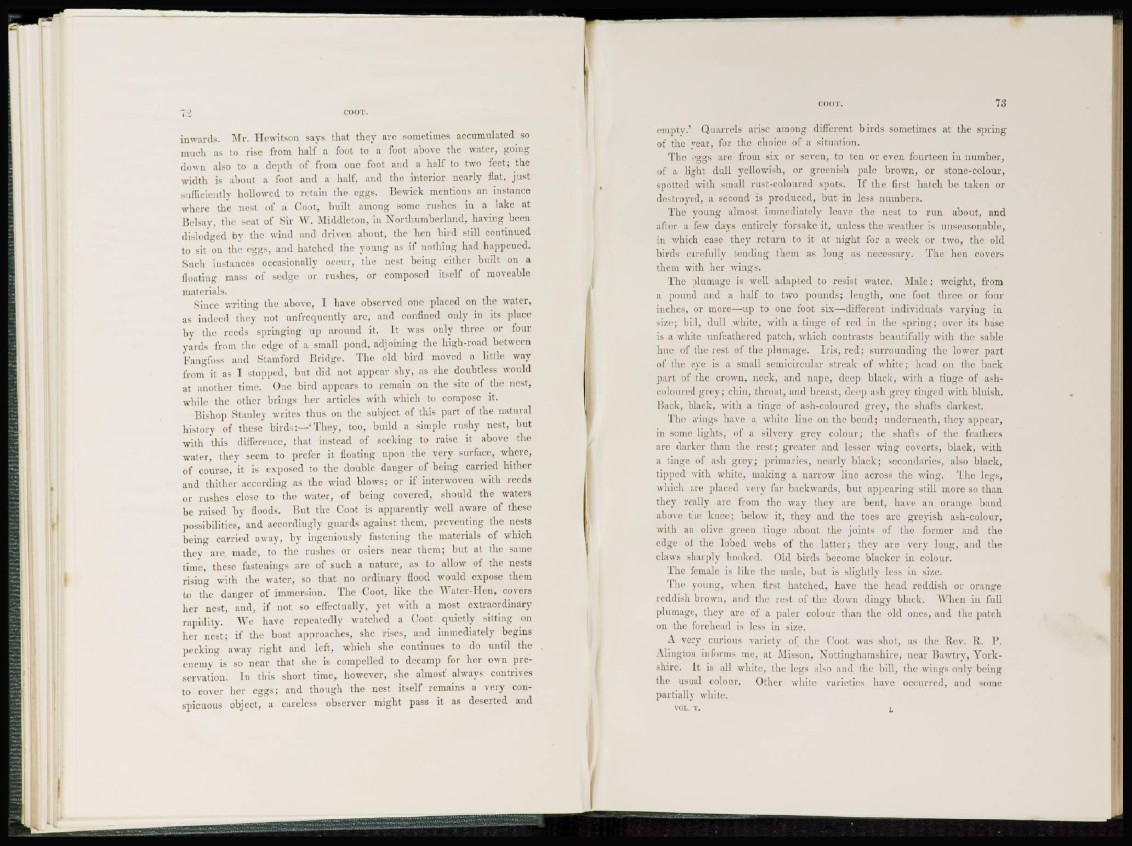
inwards. Mr. Hewitson says that they arc sometimes accumulated so
much as to rise from half a foot to a foot above the water, going
down also to a depth of from one foot and a half to two feet; the
width Is about a foot and a half, and (he interior nearly flat, just
sufficiently hollowed to retain the eggs. Bewick mentions an instance
where the nest of a Coot, built among some rushes in a lake at
Belsay, the seat of Sir W. Middleton, in Northumberland, having been
dislodged by the wind and driven about, the hen bird still continued
to sit on the eggs, and hatched the young as if nothing had happened.
Such instances occasionally occur, the nest being either buill on a
floating mass of sedge or rushes, or composed itself of moveable
materials.
Since writing the above, I have observed one placed on the water,
as indeed they not unfrequently are, and confined only in its place
by the reeds springing up around it. It was only three or four
yards from the edge of a small pond, adjoining the high-road between
Fangfosi and Stamford Bridge. The old bird moved a little way
from it as I stopped, but did not appear shy, as she doubtless would
at another time. One bird appears to remain on the site of the nest,
while the other brings her articles with which to compose it.
Bishop Stanley writes thus on the subject of this part of the natural
history of these birds:—' They, too, build a simple rushy nest, hut
with this differeuce, that instead of seeking to raise it above the
water, they seem to prefer it floating upon the very surface, where,
of course, it is exposed to the double danger of being carried hither
and thither according as the wind blows; or if interwoven with reeds
or rushes close to the water, of being covered, should the waters
be raised by floods. But the Coot is apparently well aware of these
possibilities, and accordingly guards against them, preventing the nests
being carried away, by ingeniously fastening the materials of which
they are made, to the rushes or osiers near them; but at the same
time, these fastenings are of such a nature, as to allow of the nests
rising with the water, so that no ordinary flood would expose them
to the danger of immersion. The Coot, like the AVater-TIen, covers
her nest, and, if not so effectually, yet with a most extraordinary
rapidity. We have repeatedly watched a Coot quietly sitting on
her nest; if the boat approaches, she rises, and immediately begins
pecking away right and left, which she continues to do until the
enemy is so near that she is compelled to decamp for her own preservation.
In this short time, however, she almost always contrives
to cover her eggs; and though the nest itself remains a very conspicuous
object, a careless observer might pass it as deserted and
COOT. 73
empty.' Quarrels arise among different birds sometimes at the spring
of the year, for the choice of a situation.
The eggs are from six or seven, to ten or even fourteen in number,
of a light dull yellowish, or greenish pale brown, or stone-colour,
spotted with small rust-coloured spots. Tf the first hatch be taken oldest
toyed, a second is produced, but in less numbers.
The young almost immediately leave the nest to run about, and
after a few days entirely forsake it, unless the weather is unseasonable,
tn which case they return to it at night for a week or two, the old
birds carefully tending them as long as necessary. The hen covers
them with her wings.
The plumage is well adapted to resist water. Male; weight, from
a pound and a half to two pounds; length, one foot three or four
inches, or more—up to one foot six—different individuals varying in
size; bill, dull white, with a tinge of red in the spring; over its base
is a white unfeathered patch, which contrasts beautifully with the sable
hue of the rest of the plumage. Iris, red; surrounding the lower part
of the eye is a small semicircular streak of white; head on the back
part of the crown, neck, and nape, deep black, with a tinge of ashcoloured
grey; chin, throat, and breast, deep ash grey tinged with bluish.
Back, black, with a tinge of ash-coloured grey, the shafts darkest.
The wings have a white line on the bend; underneath, they appear,
in some lights, of a silvery grey colour; the shafts of the feathers
are darker than the rest; greater and lesser wing coverts, black, with
a tinge of ash grey; primaries, nearly black; secondaries, also black,
tipped with white, making a narrow line across the wing. The legs,
which are placed very far backwards, but appearing still more so than
they really arc from the way tliey are bent, have an orange band
above the knee; below it, they and the toes are greyish ash-colour,
with an olive green tinge about, the joints of the former and the
edge of the lobed webs of the latter; they are verv long, and the
claws sharply hooked. Old birds become blacker in colour.
The female is like the; male, but is slightly less in size.
'flie young, when first hatched, have the head reddish or orange
reddish brown, and the rest of the down dingy black. When in full
plumage, they are of a paler colour than the old ones, and the patch
on the forehead is less in size.
A very curious variety of the Coot was shot, as the "Rev. 11. 1'.
Alingrou informs me, at Misson, Nottinghamshire, near Bawtry, Yorkshire.
It is all white, the legs also and the bill, the wings only being
the usual colour. Other white varieties have occurred, and some
partially white.
VOL. V. 1